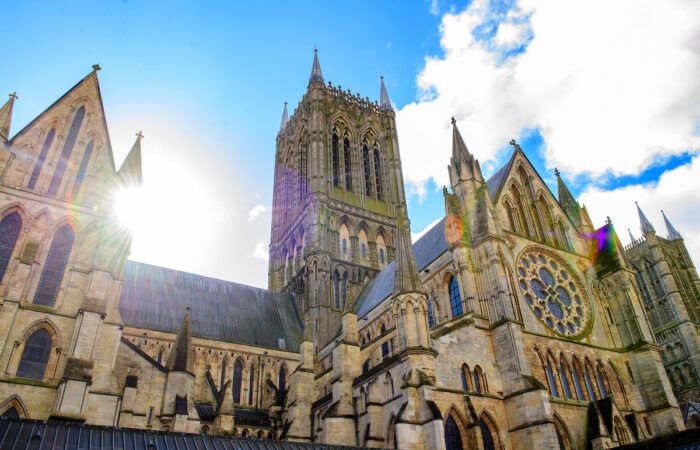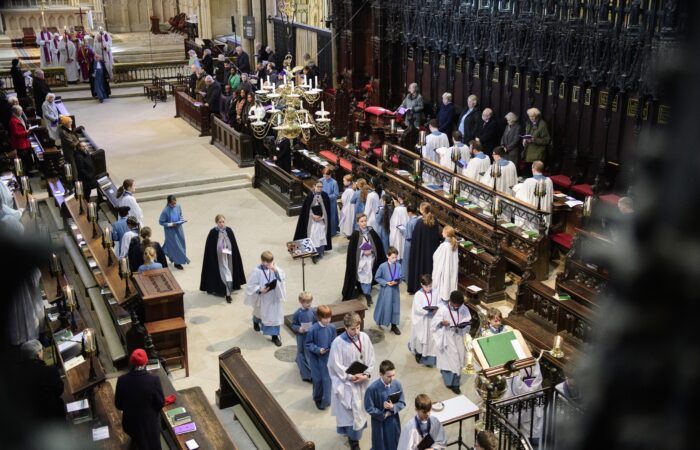Friday 17 November 2017
Sermon by The Very Reverend Christine Wilson
St Hugh’s Day
Today we gather to celebrate St Hugh of Lincoln.
One of the most lavish descriptions of him is as “one of the most beautiful spirits that was ever incarnated in human clay. A man of the sunniest cheerfulness and of remarkable character and leadership”.
What an incredible epitaph!
Hugh was also a firm advocate of justice and in the earliest account of his life by Gerald of Wales it states “that with all his strength he effected and implemented whatever he saw would promote decency and religion and the good and honour of his church.”
He could be considered something of a forerunner of Reform and Renewal! I wonder, would he approve of the review currently being done on English Cathedrals? And the challenge of authentic witness and intentional evangelism in our churches? Reform and renewal was at the very heart of Hugh’s ministry as Bishop of Lincoln.
Not only did he restore and rebuild the cathedral building, he also established what was described as “trustworthy pillars”, the living stones made up of outstanding clergy chosen for their integrity and sound learning.
He taught of a Kingdom of heaven in which all could participate. Not just religious enthusiasts, urging the laity to demonstrate love in their hearts: to do justly, love mercy and walk humbly with God.
All this was revolutionary stuff in the days when Offices in the Church were traded as favours and instruments of political manoeuvring and bribery.
He was renowned as an astonishingly virtuous man in a time when that was deemed rather a sparse resource. He used his power for good and in the cause of advocacy for the poor and the marginalised.
Hugh restored order, decency and good governance in the Cathedral and expected the clerical dignitaries to be resident in Lincoln. To this end he opposed an effort by the government of Richard 1 to have twelve of his canons serve as royal ambassadors abroad, because that would draw them away from their duties at Lincoln.
He is often spoken of as someone who spoke truth to power, disarming kings, and yet equally at home amongst children and beggars. As Richard Loomis puts it in his introduction to his translation of The life of St Hugh: no incident in Hugh’s career so dramatically illustrates his audacious spirit in resisting violent men as his quelling of the anti-jewish riots that broke out in his diocese after the death of Henry 2nd.
We have this image of a saintly yet very human man who would have preferred to hide away in his Carthusian cell deep in contemplative prayer. He is propelled into all the power struggles and messiness of ecclesiastical and political life.
To it he brought the holiness that clung to him through his devotion to God and his commitment to shaping the kingdom he ruled according to the standards of the Kingdom of God.
After his death a great cult grew up around his saintly life. There is a lovely description of his tomb as a place of rejoicing. Pilgrims flocked in the hope of the gift of a miracle or blessing.
A scene around his shrine is captured in his Magna Vita as full of noise and bustle.
“The blind see and clap their hands, the dumb speak and their friends go shouting the wonder of it through the streets, the mad cease their shrieks and turn to tending others who are ill: candles are lit; bells ring; men and women, girls and boys, priests and people go in procession to the tomb, to which all the unfortunate are given access by night and day, and in that holy place there is jubilation.”
At the time of St Hugh, cathedral’s expressed the theological imagination of their mediaeval culture. The very structure spoke of God as the alpha and omega, the beginning and the end of all things. It was a place of total otherness, full of deep mystery and pointing to the glorious and transcendent nature of God. Yet clearly this otherness was not imbued with total silence and reverence, alongside the worship and daily offices was the adjacency of the noise and the joy of pilgrims seeking and encountering God. The colourful shrieks and bells and clapping.
Stephen Platten in Holy Ground, a recent publication about cathedrals in the 21st century, describes how the journey across the centuries towards secularization is a subtraction or removal little by little of that religious imagination. The expectation of profound or miraculous encounter with God waned.
It is what the sociologist Max Webber describes as the disenchantment of the world.
However, as we know from recent reports cathedrals are enjoying something of a revival. I heard a Radio 4 commentator describe choral music as enjoying a golden moment and Pilgrimage is more popular now than at any time since the Reformation.
Those of you who visited the recent installation in the Chapter House during the Frequency Festival may have picked up the extraordinary atmosphere it created as a liminal space. It drew many across that threshold of imagination and encounter through sight and sound and smell.
This cathedral is saturated with symbol and meaning, warmed by the prayers of many generations, open to the spiritual powers beyond ourselves. It is designed to break down the barriers of our own autonomy and self-determination and confront us with the transcendent, with the eternal and with the mystery of the ordinary made extraordinary through divine sacramental presence.
Unlike medieval pilgrims our intellects and a secular world view too often get in the way and act as buffer to the depth and the mystery of which this sacred building speaks.
If cathedrals are truly places of spiritual encounter, the thin and liminal spaces with stones and images, sounds and silences that resonate with the stories of faith and the wonder of God, then everyone who steps across the threshold is a potential pilgrim. Visitors, worshippers, tourists, staff and volunteers enter into a unique space with all the potential for a glimpse of the treasures it is ready to yield.
I love that description from the days of shrine pilgrims, of the cathedral as a place of hospitality, open all hours, bursting with joy, the doors flung wide in welcome to the blind and the dumb and the mad and the sick.
It is a story of ordinary simple folk who visited the Shrine of Saint Hugh in a journey filled with hope and expectation and were not disappointed. In their willingness to discover, they encountered something beyond themselves, beyond the mess and the uncertainty and the struggle of their lives.
They came seeking for the power and the compassion of God to be revealed and many left the place shouting about the wonders of it in the streets.
That is what is recorded about this cathedral: as a place of encounter and revelation and transformation. Not only was reform and renewal a language understood by St Hugh but I think Messy Cathedral and definitely noisier and more jubilant cathedral was also the order of the day.
It is because Cathedrals in the 21st century are recovering this sense of imagination and creativity: the willingness to open our doors to diversity and greater hospitality that we are enjoying new life and a renewed witness to the love of Christ.
As we engage in ongoing reform and renewal here at our cathedral, dare we dream of a vocation to pursue the great charisms of St Hugh: sharing his beautiful spirit, his passion for justice, his prayerful devotion towards God, his advocacy for the poor and marginalised, his challenge to the powerful and his great leadership as a servant of the city and diocese?
I hope we can say a resounding yes and by the grace of God embrace it with wise and cheerful boldness!

